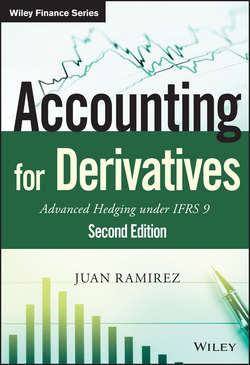Читать книгу Accounting for Derivatives - Ramirez Juan - Страница 8
На сайте Литреса книга снята с продажи.
Chapter 1
The Theoretical Framework – Recognition of Financial Instruments
1.2 THE AMORTISED COST CALCULATION: EFFECTIVE INTEREST RATE
ОглавлениеIt was mentioned earlier that some assets and liabilities are measured at amortised cost. The amortisation is calculated using the effective interest rate (EIR). This rate is applied to the carrying amount at each reporting date to determine the interest expense for the period. The EIR is the rate that exactly discounts the stream of principal and interest cash flows to the initial net outlay (in the case of assets) or proceeds (in the case of a liability). In this way, the contractual interest expense in each period is adjusted to amortise any premium, discount or transaction costs over the life of the instrument.
The carrying amount of an instrument accounted for at amortised cost is computed as:
• the amount to be repaid at maturity (usually the principal amount); plus
• any unamortised original premium, net of transaction costs; or less
• any unamortised original discount including transaction costs; less
• principal repayments; less
• any reduction for impairment or uncollectability.
Transaction costs include fees, commissions and taxes paid to other parties. Transaction costs do not include internal administrative costs.
1.2.1 Example of Effective Interest Rate Calculation – Fixed Rate Bond
Suppose that an entity issues a bond with the following terms:
The EIR is computed as the rate that exactly discounts estimated future cash payments through the expected life of the financial instrument:
Solving this equation, we get EIR = 9.96 %. The amortised cost of the liability at each accounting date is computed as follows:
1.2.2 Effective Interest Rate Calculation – Floating Rate Debt
IFRS 9 does not specify how the EIR is calculated for floating rate debt instruments. The EIR of a floating rate instrument changes as a result of periodic re-estimation of determinable cash flows to reflect movements in market interest rates. Two approaches can be used to calculate the EIR in a floating rate debt instrument:
• calculation based on the actual benchmark rate that was set for the relevant period; or
• calculation using the method employed for fixed rate debt (i.e., estimating the EIR at the beginning of each interest period taking into account the expected interest rates in each future interest period).
When the floating rate instrument is recognised at an amount equal to the principal receivable or payable on maturity, this periodic re-estimation does not have a significant effect on its carrying amount. Therefore, for practical reasons the first approach is used, and in such cases the carrying amount is usually not adjusted at each repricing date, because the impact is generally insignificant. According to this method, the interest income for the period is calculated as follows:
Similarly, for floating rate debt liabilities, the following method is used to calculate interest expense for the period:
The treatment of an acquisition discount or premium on a floating rate instrument depends on the reason for that discount or premium. For example:
• When the discount (or premium) reflects changes in market rates since the last repricing date, it is amortised to the next repricing date.
• When the discount (or premium) results from a change in the credit spread over the floating rate as a result of a change in credit risk, it is amortised over the expected life of the instrument.
IFRS 9 does not prescribe any specific methodology for how transaction costs should be amortised for a floating rate instrument. Any consistent methodology that would establish a reasonable basis for amortisation of the transaction costs may be used. For example, it would be reasonable to determine an amortisation schedule of the transaction costs based on the interest rate in effect at inception. In my view, this approach also could be applied for a floating rate instrument recognised at amortised cost with an embedded derivative that is not separated (e.g., a floating rate bond with a cap). Another reasonable approach would be to linearly amortise the transaction costs over the life of the instrument.
